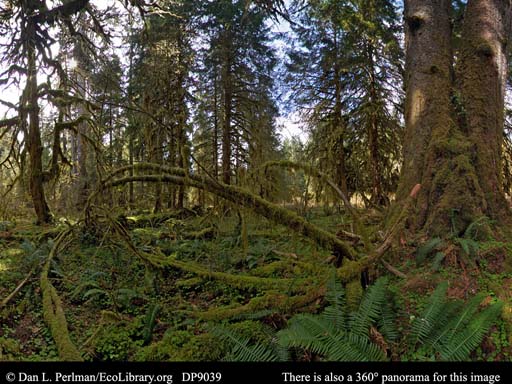Panorama: temperate rainforest
| Title | Info |
|---|---|
| Common name | Spruce, Sitka |
| Scientific name | Picea sitchensis |
| Taxonomic group | Pinaceae |
| Source | Dan L. Perlman |
| Ecosystems | Forests |
| Forests | Temperate rainforest |
| Nutrient cycles | Nitrogen; Decomposition |
| Change over time | Decomposition |
| Conservation | Nature preserves |
| Lessons | Panoramas |
| Date | April 14, 2010 |
| Location | Hoh River Valley,Olympic National Park,Washington,USA,North America |

Panorama Viewing: Click the "View Panorama" button to see an interactive panorama. Click and drag your mouse in any direction to view other parts of the scene; press the Shift key to zoom in to see details and press Ctrl to zoom out.
We recommend using the Deval VR viewer for seeing panoramas that do NOT have sound and the QuickTime viewer for panoramas WITH sound.
Temperate rainforests occur very few places on the planet, and a narrow strip of the Pacific coast of North America is the best area to see this remarkable ecosystem type. The Hoh River Valley is reported to receive about 3.5-4m (12-14ft) of rainfall per year, which creates a forest dripping with epiphytes (plants that grow on other plants), as seen here. In addition, some of these North American temperate rainforests are thought to contain more biomass per unit area than any other terrestrial ecosystem, although the diversity of species found here is just a small fraction of a tropical rainforest. Just to the right of the large double-trunked Sitka spruce you can see a slowly decaying "nurse log" that supports several young trees that began life as seedlings on the log.